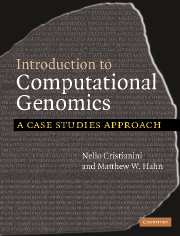Book contents
- Frontmatter
- Contents
- Preface
- Prologue: In praise of cells
- Chapter 1 The first look at a genome
- Chapter 2 All the sequence's men
- Chapter 3 All in the family
- Chapter 4 The boulevard of broken genes
- Chapter 5 Are Neanderthals among us?
- Chapter 6 Fighting HIV
- Chapter 7 SARS – a post-genomic epidemic
- Chapter 8 Welcome to the hotel Chlamydia
- Chapter 9 The genomics of wine-making
- Chapter 10 A bed-time story
- Bibliography
- Index
Chapter 5 - Are Neanderthals among us?
Variation within and between species
Published online by Cambridge University Press: 05 June 2012
- Frontmatter
- Contents
- Preface
- Prologue: In praise of cells
- Chapter 1 The first look at a genome
- Chapter 2 All the sequence's men
- Chapter 3 All in the family
- Chapter 4 The boulevard of broken genes
- Chapter 5 Are Neanderthals among us?
- Chapter 6 Fighting HIV
- Chapter 7 SARS – a post-genomic epidemic
- Chapter 8 Welcome to the hotel Chlamydia
- Chapter 9 The genomics of wine-making
- Chapter 10 A bed-time story
- Bibliography
- Index
Summary
In 1856, workers involved in limestone blasting operations near Düsseldorf, Germany, in the Neander Thal (Neander Valley) discovered a strange human skeleton. The skeleton had very unusual features, including a heavy browridge, a large nose, receding chin, and stocky build. Initially neglected, the importance of the finding was recognized only many years later by the Irish anatomist William King. The skeleton belonged to an ancient species of hominid biologically different from modern humans. King called the specimen Neanderthal Man: man of the Neander Valley. The skeleton was dated to about 44 thousand years ago.
Mutations and substitutions
Genetic distance
Statistical estimations: Kimura, Jukes-Cantor
Since then, many other skeletons of the same species, H. neanderthalensis, have been discovered in Europe. Popular imagination has been captured by the image of these cavemen; the name itself has become a symbol of prehistoric humans. It has been possible to reconstruct the lifestyle of Neanderthals in prehistoric Europe based on the tools that they used, but one fundamental question remained: are Neanderthals our ancestors? Are modern Europeans the offspring of these primitive hominids? This question has divided scientists for decades, and has only been settled recently by genetic analysis.
Many other fundamental questions about human origins have been answered by modern genetics, as well as by recent fossil discoveries. The search for the oldest hominid fossils has continually revealed evidence that humans originated in sub-Saharan Africa.
- Type
- Chapter
- Information
- Introduction to Computational GenomicsA Case Studies Approach, pp. 78 - 95Publisher: Cambridge University PressPrint publication year: 2006



